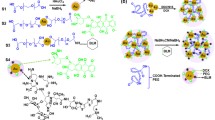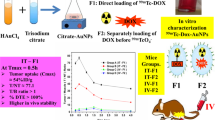Abstract
Studies on the influence of one critical parameter (e.g., size), targeting a specific disease, while keeping other factors unchanged, are important for improving understanding and application of the molecular design of biomedical nanomaterials. In this study, we used doxorubicin (Dox)-conjugated gold nanoparticles (GNPs) to investigate the effects of the size of the gold core (10, 20, or 60 nm) on the performance of their conjugates. We found that all three conjugates differed slightly in their physicochemical properties, facilitating a direct and accurate assessment of the size effects of GNP-Dox conjugates on their in vitro and in vivo performance. The cytological properties (the cell penetration rate and efficiency, as well as the cytotoxicity) and antitumor performance (the intratumoral penetration, treatment efficacy, and biodistribution) were highly correlated to the size of the inorganic core. Among all test groups, although the conjugate with a 60-nm gold core had the highest drug loading and release efficiency, the conjugate with a 10-nm gold core displayed the best antitumor efficacy toward the liver cancer models. This was because it showed the deepest tumor permeability and the highest tumor cell-killing ability of Dox transported by the relatively small GNPs. This study provides important evidence for better understanding the effect of size on in vitro and in vivo properties of potential therapeutic nanosystems and their structure design.

Similar content being viewed by others
References
Jack, C.; Karimullah, A. S.; Leyman, R.; Tullius, R.; Rotello, V. M.; Cooke, G.; Gadegaard, N.; Barron, L. D.; Kadodwala, M. Biomacromolecular stereostructure mediates mode hybridization in chiral plasmonic nanostructures. Nano Lett. 2016, 16, 5806–5814.
Yu, J.; Yang, C.; Li, J.; Ding, Y. C.; Zhang, L.; Yousaf, M. Z.; Lin, J.; Pang, R.; Wei, L. B.; Xu, L. L. et al. Multifunctional Fe5C2 nanoparticles: A targeted theranostic platform for magnetic resonance imaging and photoacoustic tomography-guided photothermal therapy. Adv. Mater. 2014, 26, 4114–4120.
Yang, Y. N.; Yu, C. Z. Advances in silica based nanoparticles for targeted cancer therapy. Nanomed.: Nanotechnol. Biol. Med. 2016, 12, 317–332.
Wang, S.; Huang, P.; Chen, X. Y. Hierarchical targeting strategy for enhanced tumor tissue accumulation/retention and cellular internalization. Adv. Mater. 2016, 28, 7340–7364.
Ye, Y. Q.; Wang, J. Q.; Hu, Q. Y.; Hochu, G. M.; Xin, H. L.; Wang, C.; Gu, Z. Synergistic transcutaneous immunotherapy enhances antitumor immune responses through delivery of checkpoint inhibitors. ACS Nano 2016, 10, 8956–8963.
Lu, F.; Wu, S. H.; Hung, Y.; Mou, C. Y. Size effect on cell uptake in well-suspended, uniform mesoporous silica nanoparticles. Small 2009, 5, 1408–1413.
Hoshyar, N.; Gray, S.; Han, H. B.; Bao, G. The effect of nanoparticle size on in vivo pharmacokinetics and cellular interaction. Nanomedicine 2016, 11, 673–692.
Goodman, C. M.; McCusker, C. D.; Yilmaz, T.; Rotello, V. M. Toxicity of gold nanoparticles functionalized with cationic and anionic side chains. Bioconjugate Chem. 2004, 15, 897–900.
Connor, E. E.; Mwamuka, J.; Gole, A.; Murphy, C. J.; Wyatt, M. D. Gold nanoparticles are taken up by human cells but do not cause acute cytotoxicity. Small 2005, 1, 325–327.
Pernodet, N.; Fang, X. H.; Sun, Y.; Bakhtina, A.; Ramakrishnan, A.; Sokolov, J.; Ulman, A.; Rafailovich, M. Adverse effects of citrate/gold nanoparticles on human dermal fibroblasts. Small 2006, 2, 766–773.
Forner, A.; Llovet, J. M.; Bruix, J. Hepatocellular carcinoma. Lancet 2012, 379, 1245–1255.
Gauthier, A.; Ho, M. Role of sorafenib in the treatment of advanced hepatocellular carcinoma: An update. Hepatol. Res. 2013, 43, 147–154.
Murata, S.; Mine, T.; Sugihara, F.; Yasui, D.; Yamaguchi, H.; Ueda, T.; Onozawa, S.; Kumita, S. I. Interventional treatment for unresectable hepatocellular carcinoma. World J. Gastroenterol. 2014, 20, 13453–13465.
Rasool, M.; Rashid, S.; Arooj, M.; Ansari, S. A.; Khan, K. M.; Malik, A.; Naseer, M. I.; Zahid, S.; Manan, A.; Asif, M. et al. New possibilities in hepatocellular carcinoma treatment. Anticancer Res. 2014, 34, 1563–1571.
Ding, Y.; Zhou, Y. Y.; Chen, H.; Geng, D. D.; Wu, D. Y.; Hong, J.; Shen, W. B.; Hang, T. J.; Zhang, C. The performance of thiol-terminated PEG-paclitaxel-conjugated gold nanoparticles. Biomaterials 2013, 34, 10217–10227.
Cui, T.; Liang, J. J.; Chen, H.; Geng, D. D.; Jiao, L.; Yang, J. Y.; Qian, H.; Zhang, C.; Ding, Y. Performance of doxorubicin-conjugated gold nanoparticles: Regulation of drug location. ACS Appl. Mater. Interfaces 2017, 9, 8569–8580.
Chauhan, V. P.; Stylianopoulos, T.; Martin, J. D.; Popovic, Z.; Chen, O.; Kamoun, W. S.; Bawendi, M. G.; Fukumura, D.; Jain, R. K. Normalization of tumour blood vessels improves the delivery of nanomedicines in a size-dependent manner. Nat. Nanotechnol. 2012, 7, 383–388.
Chithrani, D. B. Intracellular uptake, transport, and processing of gold nanostructures. Mol. Membr. Biol. 2010, 27, 299–311.
Yohan, D.; Cruje, C.; Lu, X. F.; Chithrani, D. B. Sizedependent gold nanoparticle interaction at nano-micro interface using both monolayer and multilayer (tissue-like) cell models. Nano-Micro Lett. 2016, 8, 44–53.
Dubcek, P.; Pivac, B.; Miloševic, S.; Krstulovic, N.; Kregar, Z.; Bernstorff, S. Texture of GaAs nanoparticles deposited by pulsed laser ablation in different atmospheres. ISRN Nanomater. 2013, 2013, 576506.
Chou, L. Y. T.; Song, F. Y.; Chan, W. C. W. Engineering the structure and properties of DNA-nanoparticle superstructures using polyvalent counterions. J. Am. Chem. Soc. 2016, 138, 4565–4572.
Meena, S. K.; Celiksoy, S.; Schäfer, P.; Henkel, A.; Sönnichsen, C.; Sulpizi, M. The role of halide ions in the anisotropic growth of gold nanoparticles: A microscopic, atomistic perspective. Phys. Chem. Chem. Phys. 2016, 18, 13246–13254.
Wang, G. J.; Yao, G. W.; Ma, S. Y.; Chen, B. L. Effects of different reductants on the synthesis of Au nanoparticles. Chem. World 2011, 52, 129–132.
Lévy, R.; Thanh, N. T. K.; Doty, R. C.; Hussain, I.; Nichols, R. J.; Schiffrin, D. J.; Brust, M.; Fernig, D. G. Rational and combinatorial design of peptide capping ligands for gold nanoparticles. J. Am. Chem. Soc. 2004, 126, 10076–10084.
Link, S.; El-Sayed, M. A. Size and temperature dependence of the plasmon absorption of colloidal gold nanoparticles. J. Phys. Chem. B 1999, 103, 4212–4217.
Nath, N.; Chilkoti, A. Label-free biosensing by surface plasmon resonance of nanoparticles on glass: Optimization of nanoparticle size. Anal. Chem. 2004, 76, 5370–5378.
Hill, H. D.; Millstone, J. E.; Banholzer, M. J.; Mirkin, C. A. The role radius of curvature plays in thiolated oligonucleotide loading on gold nanoparticles. ACS Nano 2009, 3, 418–424.
Cederquist, K. B.; Keating, C. D. Curvature effects in DNA: Au nanoparticle conjugates. ACS Nano 2009, 3, 256–260.
Chithrani, B. D.; Ghazani, A. A.; Chan, W. C. W. Determining the size and shape dependence of gold nanoparticle uptake into mammalian cells. Nano Lett. 2006, 6, 662–668.
Taylor, U.; Rehbock, C.; Streich, C.; Rath, D.; Barcikowski, S. Rational design of gold nanoparticle toxicology assays: A question of exposure scenario, dose and experimental setup. Nanomedicine 2014, 9, 1971–1989.
Liu, X.; Xiang, J. J.; Zhu, D. C.; Jiang, L. M.; Zhou, Z. X.; Tang, J. B.; Liu, X. R.; Huang, Y. Z.; Shen, Y. Q. Fusogenic reactive oxygen species triggered charge-reversal vector for effective gene delivery. Adv. Mater. 2016, 28, 1743–1752.
Lim, Z. Z. J.; Li, J. E. J.; Ng, C. T.; Yung, L. Y. L.; Bay, B. H. Gold nanoparticles in cancer therapy. Acta Pharmacol. Sin. 2011, 32, 983–990.
Zhang, X. D.; Wu, D.; Shen, X.; Chen, J.; Sun, Y. M.; Liu, P. X.; Liang, X. J. Size-dependent radiosensitization of PEG-coated gold nanoparticles for cancer radiation therapy. Biomaterials. 2012, 33, 6408–6419.
Jiang, W.; Kim, B. Y. S.; Rutka, J. T.; Chan, W. C. W. Nanoparticle-mediated cellular response is size-dependent. Nat. Nanotechnol. 2008, 3, 145–150.
Park, J.; Estrada, A.; Schwartz, J. A.; Diagaradjane, P.; Krishnan, S.; Dunn, A. K.; Tunnell, J. W. Intra-organ biodistribution of gold nanoparticles using intrinsic twophoton- induced photoluminescence. Laser. Surg. Med. 2010, 42, 630–639.
Saha, K.; Kim, S. T.; Yan, B.; Miranda, O. R.; Alfonso, F. S.; Shlosman, D.; Rotello, V. M. Surface functionality of nanoparticles determines cellular uptake mechanisms in mammalian cells. Small 2013, 9, 300–305.
Chen, S.; Cheng, A. C.; Wang, M. S.; Peng, X. Detection of apoptosis induced by new type gosling viral enteritis virus in vitro through fluorescein annexin V-FITC/PI double labeling. World J. Gastroenterol. 2008, 14, 2174–2178.
Ye, Y. Y.; Liu, J. W.; Xu, J. H.; Sun, L. J.; Chen, M. C.; Lan, M. B. Nano-SiO2 induces apoptosis via activation of p53 and Bax mediated by oxidative stress in human hepatic cell line. Toxicol. in Vitro 2010, 24, 751–758.
Qiu, N. S.; Liu, X. R.; Zhong, Y.; Zhou, Z. X.; Piao, Y.; Miao, L.; Zhang, Q. Z.; Tang, J. B.; Huang, L.; Shen, Y. Q. Esterase-activated charge-reversal polymer for fibroblastexempt cancer gene therapy. Adv. Mater. 2016, 28, 10613–10622.
Carvalho, F. S.; Burgeiro, A.; Garcia, R.; Moreno, A. J.; Carvalho, R. A.; Oliveira, P. J. Doxorubicin-induced cardiotoxicity: From bioenergetic failure and cell death to cardiomyopathy. Med. Res. Rev. 2014, 34, 106–135.
Acknowledgements
This work was financially supported by the National Natural Science Foundation of China (Nos. 31470916, 31500769, 51672010, and 81421004), the Fundamental Research Funds for the Central Universities (Nos. 2015PT036 and 2016PT014), the Priority Academic Program Development of Jiangsu Higher Education Institutions, and the Open Project Program of MOE Key Laboratory of Drug Quality Control and Pharmacovigilance (No. DQCP2015MS01).
Author information
Authors and Affiliations
Corresponding authors
Electronic supplementary material
Rights and permissions
About this article
Cite this article
Wu, D., Wang, H., Hou, X. et al. Effects of gold core size on regulating the performance of doxorubicin-conjugated gold nanoparticles. Nano Res. 11, 3396–3410 (2018). https://doi.org/10.1007/s12274-017-1963-y
Received:
Revised:
Accepted:
Published:
Issue Date:
DOI: https://doi.org/10.1007/s12274-017-1963-y




